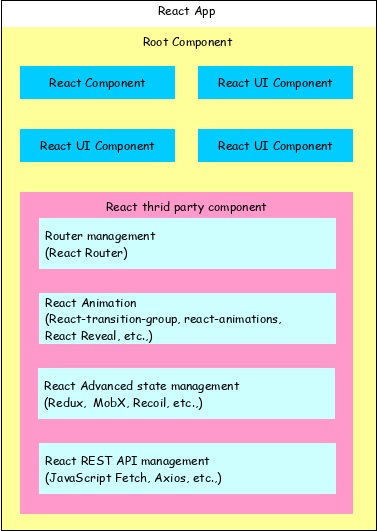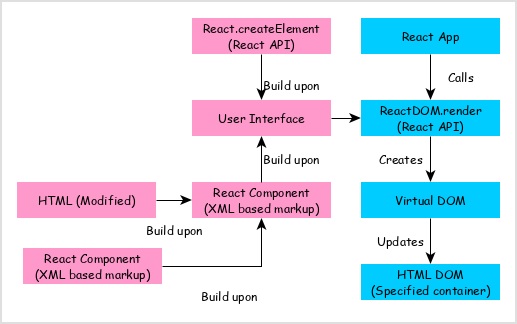
- ReactJS - Home
- ReactJS - Introduction
- ReactJS - Roadmap
- ReactJS - Installation
- ReactJS - Features
- ReactJS - Advantages & Disadvantages
- ReactJS - Architecture
- ReactJS - Creating a React Application
- ReactJS - JSX
- ReactJS - Components
- ReactJS - Nested Components
- ReactJS - Using Newly Created Components
- ReactJS - Component Collection
- ReactJS - Styling
- ReactJS - Properties (props)
- ReactJS - Creating Components using Properties
- ReactJS - props Validation
- ReactJS - Constructor
- ReactJS - Component Life Cycle
- ReactJS - Event management
- ReactJS - Creating an Event−Aware Component
- ReactJS - Introduce Events in Expense Manager APP
- ReactJS - State Management
- ReactJS - State Management API
- ReactJS - Stateless Component
- ReactJS - State Management Using React Hooks
- ReactJS - Component Life Cycle Using React Hooks
- ReactJS - Layout Component
- ReactJS - Pagination
- ReactJS - Material UI
- ReactJS - Http client programming
- ReactJS - Form Programming
- ReactJS - Controlled Component
- ReactJS - Uncontrolled Component
- ReactJS - Formik
- ReactJS - Conditional Rendering
- ReactJS - Lists
- ReactJS - Keys
- ReactJS - Routing
- ReactJS - Redux
- ReactJS - Animation
- ReactJS - Bootstrap
- ReactJS - Map
- ReactJS - Table
- ReactJS - Managing State Using Flux
- ReactJS - Testing
- ReactJS - CLI Commands
- ReactJS - Building and Deployment
- ReactJS - Example
- Hooks
- ReactJS - Introduction to Hooks
- ReactJS - Using useState
- ReactJS - Using useEffect
- ReactJS - Using useContext
- ReactJS - Using useRef
- ReactJS - Using useReducer
- ReactJS - Using useCallback
- ReactJS - Using useMemo
- ReactJS - Custom Hooks
- ReactJS Advanced
- ReactJS - Accessibility
- ReactJS - Code Splitting
- ReactJS - Context
- ReactJS - Error Boundaries
- ReactJS - Forwarding Refs
- ReactJS - Fragments
- ReactJS - Higher Order Components
- ReactJS - Integrating With Other Libraries
- ReactJS - Optimizing Performance
- ReactJS - Profiler API
- ReactJS - Portals
- ReactJS - React Without ES6 ECMAScript
- ReactJS - React Without JSX
- ReactJS - Reconciliation
- ReactJS - Refs and the DOM
- ReactJS - Render Props
- ReactJS - Static Type Checking
- ReactJS - Strict Mode
- ReactJS - Web Components
- Additional Concepts
- ReactJS - Date Picker
- ReactJS - Helmet
- ReactJS - Inline Style
- ReactJS - PropTypes
- ReactJS - BrowserRouter
- ReactJS - DOM
- ReactJS - Carousel
- ReactJS - Icons
- ReactJS - Form Components
- ReactJS - Reference API
- ReactJS Useful Resources
- ReactJS - Quick Guide
- ReactJS Cheatsheet
- Axios CheatSheet
- ReactJS - Useful Resources
- ReactJS - Discussion
ReactJS - Architecture
React library is built on a solid foundation. It is simple, flexible and extensible. As we learned earlier, React is a library to create user interface in a web application. React's primary purpose is to enable the developer to create user interface using pure JavaScript. Normally, every user interface library introduces a new template language (which we need to learn) to design the user interface and provides an option to write logic, either inside the template or separately.
Instead of introducing new template language, React introduces three simple concepts as given below −
React elements
JavaScript representation of HTML DOM. React provides an API, React.createElement to create React Element.
JSX
A JavaScript extension to design user interface. JSX is an XML based, extensible language supporting HTML syntax with little modification. JSX can be compiled to React Elements and used to create user interface.
React component
React component is the primary building block of the React application. It uses React elements and JSX to design its user interface. React component is basically a JavaScript class (extends the React.component class) or pure JavaScript function. React component has properties, state management, life cycle and event handler. React component can be able to do simple as well as advanced logic.
Let us learn more about components in the React Component chapter.
Architecture of the React Application
React library is just UI library and it does not enforce any particular pattern to write a complex application. Developers are free to choose the design pattern of their choice. React community advocates certain design pattern. One of the patterns is Flux pattern. React library also provides lot of concepts like Higher Order component, Context, Render props, Refs etc., to write better code. React Hooks is evolving concept to do state management in big projects. Let us try to understand the high level architecture of a React application.

React app starts with a single root component.
Root component is build using one or more component.
Each component can be nested with other component to any level.
Composition is one of the core concepts of React library. So, each component is build by composing smaller components instead of inheriting one component from another component.
Most of the components are user interface components.
React app can include third party component for specific purpose such as routing, animation, state management, etc.
Workflow of a React application
Let us understand the workflow of a React application in this chapter by creating and analyzing a simple React application.
Open a command prompt and go to your workspace.
cd /go/to/your/workspace
Next, create a folder, static_site and change directory to newly created folder.
mkdir static_site cd static_site
Example
Next, create a file, hello.html and write a simple React application.
<!DOCTYPE html>
<html>
<head>
<meta charset="UTF-8" />
<title>React Application</title>
</head>
<body>
<div id="react-app"></div>
<script src="https://unpkg.com/react@17/umd/react.development.js" crossorigin></script>
<script src="https://unpkg.com/react-dom@17/umd/react-dom.development.js" crossorigin></script>
<script language="JavaScript">
element = React.createElement('h1', {}, 'Hello React!')
ReactDOM.render(element, document.getElementById('react-app'));
</script>
</body>
</html>
Next, serve the application using serve web server.
serve ./hello.html
Output
Next, open your favorite browser. Enter http://localhost:5000 in the address bar and then press enter.

Let us analyse the code and do little modification to better understand the React application.
Here, we are using two API provided by the React library.
React.createElement
Used to create React elements. It expects three parameters −
- Element tag
- Element attributes as object
- Element content - It can contain nested React element as well
ReactDOM.render
Used to render the element into the container. It expects two parameters −
- React Element OR JSX
- Root element of the webpage
Nested React element
As React.createElement allows nested React element, let us add nested element as shown below −
Example
<script language="JavaScript">
element = React.createElement('div', {}, React.createElement('h1', {}, 'Hello React!'));
ReactDOM.render(element, document.getElementById('react-app'));
</script>
Output
It will generate the below content −
<div><h1> Hello React!</h1></div>
Use JSX
Next, let us remove the React element entirely and introduce JSX syntax as shown below −
<!DOCTYPE html>
<html>
<head>
<meta charset="UTF-8" />
<title>React Application</title>
</head>
<body>
<div id="react-app"></div>
<script src="https://unpkg.com/react@17/umd/react.development.js" crossorigin></script>
<script src="https://unpkg.com/react-dom@17/umd/react-dom.development.js" crossorigin></script>
<script src="https://unpkg.com/@babel/standalone/babel.min.js"></script>
<script type="text/babel">
ReactDOM.render(
<div><h1>Hello React!</h1></div>,
document.getElementById('react-app')
);
</script>
</body>
</html>
Here, we have included babel to convert JSX into JavaScript and added type="text/babel" in the script tag.
<script src="https://unpkg.com/@babel/standalone/babel.min.js"></script> <script type="text/babel"> ... ... </script>
Next, run the application and open the browser. The output of the application is as follows −

Next, let us create a new React component, Greeting and then try to use it in the webpage.
<script type="text/babel">
function Greeting() {
return <div><h1>Hello JSX!</h1></div>
}
ReactDOM.render(<Greeting />, document.getElementById('react-app') );
</script>
The result is same and as shown below −

By analyzing the application, we can visualize the workflow of the React application as shown in the below diagram.

React app calls ReactDOM.render method by passing the user interface created using React component (coded in either JSX or React element format) and the container to render the user interface.
ReactDOM.render processes the JSX or React element and emits Virtual DOM.
Virtual DOM will be merged and rendered into the container.
Architecture of the React Application
React library is just UI library and it does not enforce any particular pattern to write a complex application. Developers are free to choose the design pattern of their choice. React community advocates certain design pattern. One of the patterns is Flux pattern. React library also provides lot of concepts like Higher Order component, Context, Render props, Refs etc., to write better code. React Hooks is evolving concept to do state management in big projects. Let us try to understand the high level architecture of a React application.